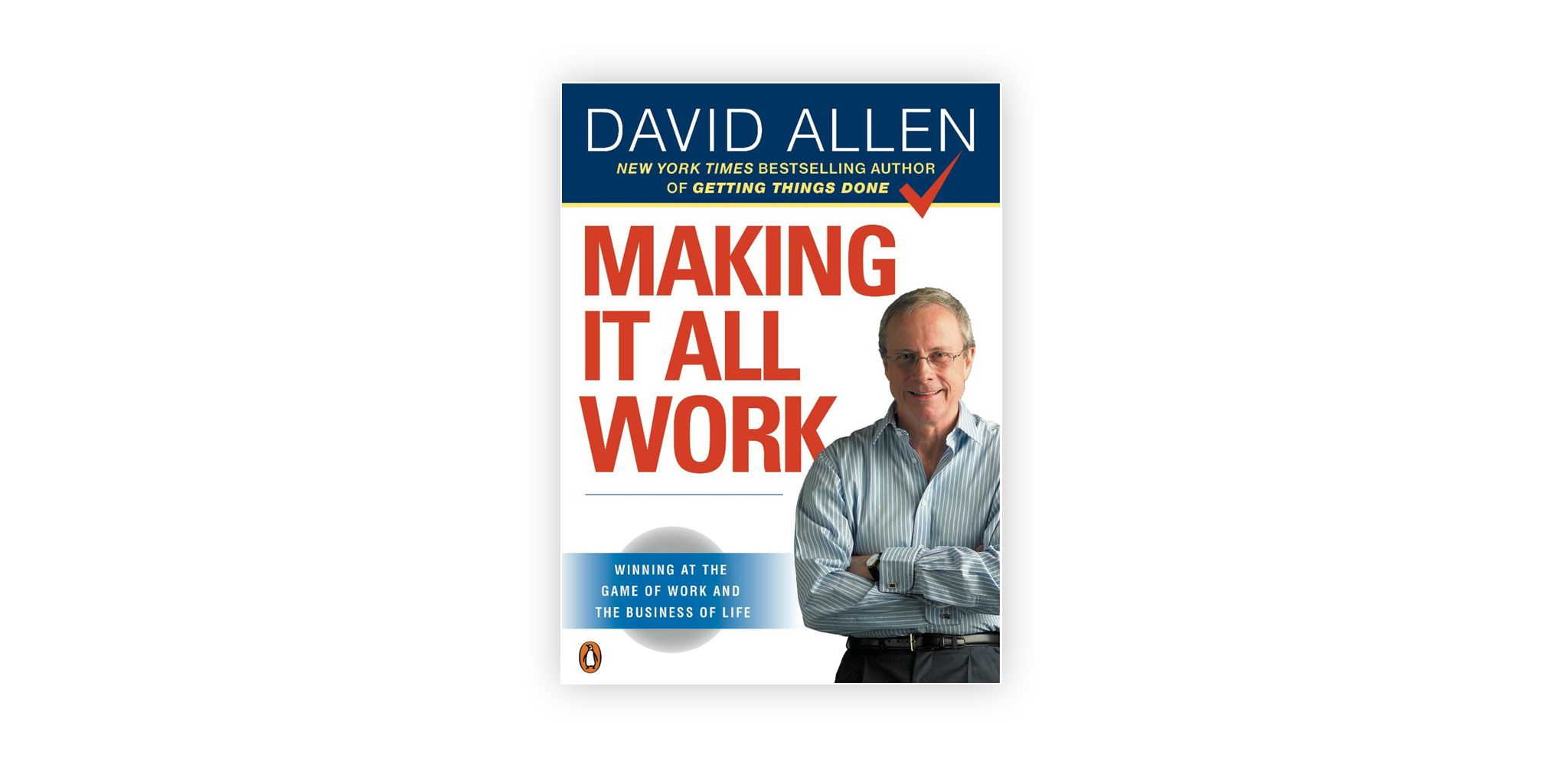Making It All Work by David Allen
David Allen’s “Making it All Work”, the highly-anticipated followup to his blockbuster Getting Things Done, offers a practical and philosophical approach to the problem of defining and processing our stuff.
He defines “stuff” expansively — it’s basically anything intruding on your cognitive architecture that isn’t properly defined.
Allen’s 2002 book Getting Things Done created an entire subculture and a set of organizing principles that have encouraged some off-the-wall innovations (Merlin Mann’s Hipster PDA, for example). Making It All Work is a complement to, rather than a substitute for, GTD, and it incorporates the insights Allen has picked up from years of coaching executives and other groups in his methods.
Allen states this explicitly on page 5: “While Getting Things Done offered a primer and a simple manual, Making It All Work is intended to provide you with a road map – one that will enhance your abilities to process life and work in tandem.”
Allen encourages his readers to be as outcome-focused as possible and to develop hard-edged systems whereby they are able to understand exactly what it is that they are doing, what it is that is required, and what the next action necessarily has to be. This is explicit on page 17: “Because what I teach is actually not a system but a systematic approach, it can be adapted to take advantage of many of the features of software applications that have seldom been used before.” As an economist I was especially impressed with the way he led off the first chapter with a quote from Thomas Sowell, who, albeit in a different context, points out that “much of what sophisticates loftily to as the ‘complexity’ of the real world is in fact the inconsistency in their own minds” (p. 1).
Allen is fond of referring to “the business of life” and “the game of work,” and this makes its first appearance on page 2 when he points out that a well-defined productivity system means that “work takes on a lighter quality, and life itself becomes a successful enterprise” and further down the page when he writes that the game of work and the business of life are really the same thing, when it comes down to the principles and behaviors and techniques that eliminate distractions and foster beneficial focus.“
Allen’s goal is clarified on page 57: "the challenge that we are dealing with in all this is getting to the state in which we can trust that what we’re doing at any point in time is what we think we should be doing.”
Of particular interest is his treatment of the false distinction between work and life. Following his earlier work, Allen offers the broadest possible definition of “work” as “anything you want to get done that’s not done yet” (p. 56) and refers to the concept of work/life balance as a “hoax” (p. 58). This flies in the face of how a lot of people think. Many organizational thinkers and leaders see “work” as “what is done in exchange for money at a place of business” while anything else is “life.” As Allen argues, this is a false distinction. In our super-productive world, a lot of us have the opportunity to find fulfilment through our work, which is an opportunity that many of our ancestors never had. Thus, Allen’s very broad definition is appropriate.
Allen introduces some new terminology — “control” and “perspective” — to describe some of his new thinking on Getting Things Done, and these are the focal points of the new book. The core of his new contribution really begins in earnest at the start of chapter 4, when he argues that “control” and “perspective” are “the two key ingredients for making it all work” (p. 60).
Much like in his earlier book, Allen relies on a number of heuristic hooks, like “the matrix of self-management,” which define different levels of perspective and control. There is the “Captain and Commander” quadrant of high perspective and high control, the “Micromanager/ Implementer” quadrant of high control and low perspective, the “Crazy Maker/ Visionary” quadrant of high perspective and little control, and finally the “Victim/ Responder” quadrant of low perspective and low control.
Obviously, the “victim/responder” quadrant is the worst place to be — it is perpetually “operating in a crisis mode” (p. 62). Micromanagement is a type of bureaucratic management where “form… will overtake function” (p. 65); This is a fundamentally bureaucratic style that emphasizes filling out the right forms at the expense of actually creating value. In yet another quadrant is the Crazy Maker/Visionary, who “take(s) on too many commitments vis-a-vis available resources” (p. 67). It is a quadrant with which most academics can likely sympathize.
The ideal in his system is the Captain and Commander. This is the person who is in his or her zone; it is someone who has “learned to walk the thin line between function and form, vision and implementation, stretch and structure” (p. 69). The key to being a “captain and commander” is to implement processes that allow you to successfully deal with what is coming at you. In other words, it is to pay attention to what has our attention (pp. 72-73).
In chapters five and beyond Allen reorients GTD along the control/perspective axes and considers the following tasks: capturing, clarifying, organizing, reflecting, (for control) and projects, areas of focus, goals, vision, and purpose/principles (for perspective). “Engaging/Actions" intersects both categories.
One of the keys that permeates Allen’s work is to define “stuff” so that it can be dealt with. It’s important for the visionary part of your mind to be disciplined to define what you want to do. In a passage that has hit close to home, Allen points out that “when you’re in this mode you can read a single issue of a magazine and generate at least a dozen things to do — restaurants to try out, cool new travel accessories to buy, six ideas that might improve the next staff meeting” (p. 108).
I’m glancing around my workspace right now and seeing magazines, journals, and books I’m avoiding right now because I’m not really clear on what I’ll do with the information once I collect it. Rearranging the piles might create short-term satisfaction, but it won’t produce long-run results (p. 111).
I would summarize Allen’s key point as follows: dross creates drag. In economics, we talk about opportunity cost. Opportunity cost is whatever we give up in order to do something, and the opportunity cost of holding onto a pile of commitments in your mind is the ideas you could be having and implementing. As he has said in various places, “your mind is for having ideas, not holding them.” Trying to use the mind to hold ideas rather than to have them reduces clarity and increases resistance.
For leaders, clarifying tasks and parameters is of paramount importance. Making It All Work provides a philosophy and a toolkit that helps us figure this out.

